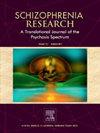自闭症谱系商在精神分裂症患者临床症状与生活质量之间的关系中起中介作用。
IF 3.6
2区 医学
Q1 PSYCHIATRY
引用次数: 0
摘要
背景:社交功能障碍会影响精神分裂症患者的生活质量。自闭症谱系商(autism-spectrum quotient, AQ)是一种被广泛使用的衡量先天性自闭症特征的方法。然而,在精神分裂症患者中,分数可能代表了自闭症样社交功能障碍的严重程度。我们测试了精神分裂症患者临床症状和生活质量之间关系的假设,该假设是基于精神分裂症患者的精神分裂症样社会功能障碍而不是自闭症特征的假设。方法:对108例精神分裂症门诊患者的资料进行分析。采用结构方程模型(SEM)分析精神分裂症患者正、负症候量表(PANSS)、生活质量量表(SQLS)和精神分裂症患者心理素质之间的关系。结果:总量表得分的通径分析显示部分中介作用,但没有完全中介作用或独立效应。然而,AQ和PANSS分数都可能是中介。SEM包括PANSS的三个域分数、AQ的两个因子和SQLS的三个子量表分数,对AQ的中介模型拟合较好,但对症状的中介模型不拟合,支持我们的假设。在最后一个模型中,阴性症状与生活质量之间的关系是由自闭症样社交功能障碍介导的,而阳性症状直接影响生活质量。结论:我们的研究结果促进了我们对应用于精神分裂症患者的AQ测量的理解,并表明自闭症样社交功能障碍是改善这一人群生活质量的重要治疗目标。本文章由计算机程序翻译,如有差异,请以英文原文为准。
Autism-spectrum quotient mediates the relationship between clinical symptoms and quality of life in schizophrenia
Background
Social dysfunctions can affect the quality of life (QOL) of patients with schizophrenia. The autism-spectrum quotient (AQ) is a widely used measure of innate autistic traits. However, in patients with schizophrenia, the score may represent the severity of autism-like social dysfunctions as a consequence of symptoms. We tested the hypothesis that AQ would mediate the relationship between clinical symptoms and QOL in patients with schizophrenia, based on the assumption that the AQ measures autism-like social dysfunctions rather than autistic traits in this population.
Methods
We analyzed data from 108 outpatients with schizophrenia. The relationships among the scores on the Positive and Negative Syndrome Scale (PANSS), the Schizophrenia Quality of Life Scale (SQLS), and the AQ were examined using structural equation modeling (SEM).
Results
Path analyses of the total scale scores revealed partial mediation, but not full mediation or independent effects. However, both the AQ and PANSS scores could be mediators. SEM including the three domain scores of PANSS, the two factors of the AQ, and the three subscale scores of the SQLS showed a good fit of the AQ mediation model, but not the symptom mediation model, supporting our hypothesis. In this final model, the relationship between negative symptoms and QOL was mediated by autism-like social dysfunctions, whereas positive symptoms directly affected QOL.
Conclusions
Our findings advance our understanding of what the AQ measures when applied to patients with schizophrenia and suggest that autism-like social dysfunctions are important treatment targets for improving QOL in this population.
求助全文
通过发布文献求助,成功后即可免费获取论文全文。
去求助
来源期刊

Schizophrenia Research
医学-精神病学
CiteScore
7.50
自引率
8.90%
发文量
429
审稿时长
10.2 weeks
期刊介绍:
As official journal of the Schizophrenia International Research Society (SIRS) Schizophrenia Research is THE journal of choice for international researchers and clinicians to share their work with the global schizophrenia research community. More than 6000 institutes have online or print (or both) access to this journal - the largest specialist journal in the field, with the largest readership!
Schizophrenia Research''s time to first decision is as fast as 6 weeks and its publishing speed is as fast as 4 weeks until online publication (corrected proof/Article in Press) after acceptance and 14 weeks from acceptance until publication in a printed issue.
The journal publishes novel papers that really contribute to understanding the biology and treatment of schizophrenic disorders; Schizophrenia Research brings together biological, clinical and psychological research in order to stimulate the synthesis of findings from all disciplines involved in improving patient outcomes in schizophrenia.
 求助内容:
求助内容: 应助结果提醒方式:
应助结果提醒方式:


